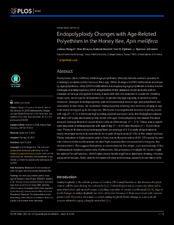| dc.creator | Rangel, Juliana | |
| dc.creator | Strauss, Kim | |
| dc.creator | Seedorf, Kaileah | |
| dc.creator | Hjelmen, Carl E. | |
| dc.creator | Johnston, J. Spencer | |
| dc.date.accessioned | 2015-08-31T03:16:50Z | |
| dc.date.available | 2015-08-31T03:16:50Z | |
| dc.date.issued | 2015-04-16 | |
| dc.identifier.citation | Rangel J, Strauss K, Seedorf K, Hjelmen CE, Johnston JS (2015) Endopolyploidy Changes with Age-Related Polyethism in the Honey Bee, Apis mellifera. PLoS ONE 10(4): e0122208. doi: 10.1371/journal.pone.0122208 | en |
| dc.identifier.uri | https://hdl.handle.net/1969.1/154847 | |
| dc.description.abstract | Honey bees (Apis mellifera) exhibit age polyethism, whereby female workers assume increasingly complex colony tasks as they age. While changes in DNA methylation accompany age polyethism, other DNA modifications accompanying age polyethism are less known. Changes in endopolyploidy (DNA amplification in the absence of cell division) with increased larval age are typical in many insect cells and are essential in adults for creating larger cells, more copies of essential loci, or greater storage capacity in secretory cells. However, changes in endopolyploidy with increased adult worker age and polyethism are unstudied. In this study, we examined endopolyploidy in honey bee workers ranging in age from newly emerged up to 55 days old. We found a nonsignificant increase in ploidy levels with age (P < 0.1) in the most highly endopolyploid secretory cells, the Malpighian tubules. All other cell types decreased ploidy levels with age. Endopolyploidy decreased the least amount (nonsignificant) in neural (brain) cells and the stinger (P < 0.1). There was a significant reduction of endopolyploidy with age in leg (P < 0.05) and thoracic (P < 0.001) muscles. Ploidy in thoracic muscle dropped from an average of 0.5 rounds of replication in newly emerged workers to essentially no rounds of replication (0.125) in the oldest workers. Ploidy reduction in flight muscle cells is likely due to the production of G1 (2C) nuclei by amitotic division in the multinucleate striated flight muscles that are essential to foragers, the oldest workers. We suggest that ploidy is constrained by the shape, size and makeup of the multinucleate striated muscle cells. Furthermore, the presence of multiple 2C nuclei might be optimal for cell function, while higher ploidy levels might be a dead-end strategy of some aging adult tissues, likely used to increase cell size and storage capacity in secretory cells. | en |
| dc.description.sponsorship | The open access fee for this work was funded through the Texas A&M University Open Access to Knowledge (OAK) Fund. | en |
| dc.language.iso | en_US | |
| dc.publisher | PLOS | |
| dc.rights | Attribution 3.0 United States | en |
| dc.rights.uri | http://creativecommons.org/licenses/by/3.0/us/ | |
| dc.subject | Ploidy | en |
| dc.subject | Honey bees | en |
| dc.subject | Insect flight | en |
| dc.subject | Flight (biology) | en |
| dc.subject | Muscle tissue | en |
| dc.subject | Legs | en |
| dc.subject | Muscle cells | en |
| dc.subject | Insects | en |
| dc.title | Endopolyploidy Changes with Age-Related Polyethism in the Honey Bee, Apis mellifera | en |
| dc.type | Article | en |
| local.department | Entomology | en |



